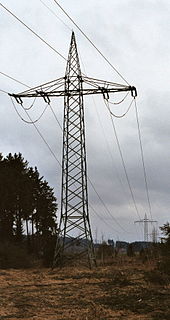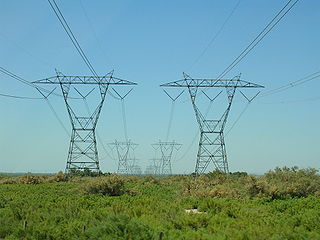
A substation is a part of an electrical generation, transmission, and distribution system. Substations transform voltage from high to low, or the reverse, or perform any of several other important functions. Between the generating station and consumer, electric power may flow through several substations at different voltage levels. A substation may include transformers to change voltage levels between high transmission voltages and lower distribution voltages, or at the interconnection of two different transmission voltages.

A transmission tower, also known as an electricity pylon or simply a pylon in British English and as a hydro tower in Canadian English, is a tall structure, usually a steel lattice tower, used to support an overhead power line.

The Pacific DC Intertie is an electric power transmission line that transmits electricity from the Pacific Northwest to the Los Angeles area using high voltage direct current (HVDC). The line capacity is 3,100 megawatts, which is enough to serve two to three million Los Angeles households and represents almost half of the Los Angeles Department of Water and Power (LADWP) electrical system's peak capacity.

The Pylons of Messina are two free-standing steel towers, the Sicilian one in Torre Faro and the Calabrian one in Villa San Giovanni. They were used from 1955 to 1994 to carry a 220 kilovolt power line across the Strait of Messina, between the Scilla substation in Calabria on the Italian mainland at 38°14′42″N15°40′59″E and the Messina-Santo substation in Sicily at 38°15′57″N15°39′04″E.

A dead-end tower is a fully self-supporting structure used in construction of overhead power lines. A dead-end transmission tower uses horizontal strain insulators at the end of conductors. Dead-end towers may be used at a substation as a transition to a "slack span" entering the equipment, when the circuit changes to a buried cable, when a transmission line changes direction by more than a few degrees, or at intervals along a straight run to limit the extent of a catastrophic collapse.

An overhead power line is a structure used in electric power transmission and distribution to transmit electrical energy across large distances. It consists of one or more uninsulated electrical cables suspended by towers or poles.
Path 27, or the Intermountain Power Project DC Line, or the Southern Transmission System is a HVDC transmission line that carries electricity from the Intermountain Power Plant near Delta, Utah to the city of Los Angeles via the Adelanto Converter Station in Adelanto, California. It is owned and operated by the Intermountain Power Agency, a large cooperative primarily owned by the Los Angeles Department of Water and Power ("LADWP") (50%) along with five other Los Angeles area cities (25%) and 30 small Utah municipalities.

A traction network or traction power network is an electricity grid for the supply of electrified rail networks. The installation of a separate traction network generally is done only if the railway in question uses alternating current (AC) with a frequency lower than that of the national grid, such as in Germany, Austria and Switzerland.

As one of the four power marketing administrations within the U.S. Department of Energy, the Western Area Power Administration (WAPA)'s role is to market wholesale hydropower generated at 56 hydroelectric federal dams operated by the Bureau of Reclamation, United States Army Corps of Engineers and the International Boundary and Water Commission. WAPA delivers this power through a more than 17,000-circuit-mile, high-voltage power transmission system to more than 700 preference power customers across the West. Those customers, in turn, provide retail electric service to more than 40 million consumers. WAPA is headquartered in the Denver, Colorado suburb of Lakewood, Colorado.
Transposition is the periodic swapping of positions of the conductors of a transmission line, in order to reduce crosstalk and otherwise improve transmission. In telecommunications this applies to balanced pairs whilst in power transmission lines three conductors are periodically transposed.

Path 15 is an 84-mile (135 km) portion of the north–south power transmission corridor in California, U.S. It forms a part of the Pacific AC Intertie and the California-Oregon Transmission Project. Path 15 is part of The Western Electricity Coordinating Council's links of electrical intertie paths in the western United States.

Path 26 is a set of three Southern California Edison (SCE) 500 kV power lines, located primarily in Los Angeles County, and extending into Kern and Ventura counties, all in California. Path 26 is part of the Western Electricity Coordinating Council's links of electrical intertie paths in the western United States. The Path 26 lines are located in: the San Joaquin Valley of the southern Central Valley; the Tehachapi Mountains and other central Transverse Ranges; and the Antelope Valley section of the Mojave Desert.
Path 64 or the Marketplace - Adelanto line is a 202-mile (325 km) 500-kilovolt power line that runs from the Adelanto substation near Adelanto, California in the High Desert to the Marketplace substation near Boulder City, Nevada. Path 64 is part of The Western Electricity Coordinating Council's links of electrical intertie paths in the western United States. Path 64 is part of the Path 46 transmission system in southeastern California. This power line is operated by Los Angeles Department of Water and Power (LADWP). This line, along with Path 27, the Intermountain DC line and other Path 46 powerlines, supply over 10,000 megawatts of electrical power to the Los Angeles area. Path 64 is an essential line for powering Los Angeles.
Path 46, also called West of Colorado River, Arizona-California West-of-the-River Path (WOR), is a set of fourteen high voltage alternating-current transmission lines that are located in southeast California and Nevada up to the Colorado River.

ITC Transmission was founded in 1999 as International Transmission Co., a subsidiary of Detroit Edison, charged in the ownership, operation and maintenance of Detroit Edison's transmission system. In 2003, DTE sold the subsidiary to ITC Holdings Corp. In 2004, ITC Transmission became the first, fully independent electricity transmission company in the United States following the 2003 transfer of ownership from DTE Energy to ITC Transmission’s parent company, ITC Holdings Corp. ITC Transmission owns a fully regulated, high-voltage system that transmits electricity to local electricity distribution facilities. ITC Holdings Corp. became a publicly traded company in 2005 and is headquartered in Novi, Michigan. Today it owns transmission systems in several states under a unique independent business model.

Hydro-Québec's electricity transmission system is an international electric power transmission system centred in Quebec, Canada. The system pioneered the use of very high voltage 735-kilovolt (kV) alternating current (AC) power lines that link the population centres of Montreal and Quebec City to distant hydroelectric power stations like the Daniel-Johnson Dam and the James Bay Project in northwestern Quebec and the Churchill Falls Generating Station in Labrador.

GKK Etzenricht, an abbreviation of Gleichstromkurzkupplung Etzenricht, meaning Etzenricht HVDC-back-to-back station, was an HVDC back-to-back facility near Etzenricht in the district of Neustadt an der Waldnaab in Bavaria, Germany. It was built on the site of the Etzenricht substation, a 380 kV/220 kV/110 kV-substation, which went into service in 1970 and expanded afterwards several times. The facility was used between 1993 and 1995 for exchange of power between Germany and the Czech Republic, operated by Bayernwerk AG.
The Mead substation is a major electric power interconnection point in the western United States. The station is located in the El Dorado Valley of Nevada just outside of Boulder City, at the end of Buchanan Boulevard south of its grade separation with Interstate 11. The facility is owned and operated by the Western Area Power Administration.

A line trap, also known as wave trap, or high-frequency stopper, is a maintenance-free parallel resonant circuit, mounted inline on high-voltage (HV) AC transmission power lines to prevent the transmission of high frequency carrier signals of power line communication to unwanted destinations. Line traps are cylinder-like structures connected in series with HV transmission lines. A line trap is also called a wave trap.
The TransWest Express Transmission Line Project (TWE) is a planned bipolar HVDC transmission line between Rawlins, Wyoming and Marketplace substation near Las Vegas.


















